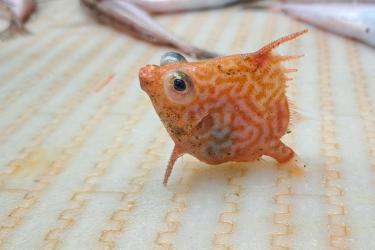Ocean acidification is just one of the ways in which coastal communities are already feeling the effects of a changing ocean. It is potentially devastating—an urgent environmental and economic issue. In 2015, the Puget Sound Restoration Fund, NOAA, and other partners received $1.5 million from the Paul G. Allen Family Foundation to tackle the impacts of ocean acidification. The project looks to employ an unlikely hero: seaweed.
“There are not a lot of tools in the tool box that can fight ocean acidification or remove carbon dioxide from the ocean,” says Dr. Michael Rust, NOAA Aquaculture Science Coordinator and a collaborator on the project. “Seaweed farms might be one of our best bets.”
Help from Kelp
Many seaweeds, including kelp, thrive in acidifying ocean waters. They take up carbon dioxide and nutrients from their environment, improving water quality as they grow by drawing down levels of the dissolved acid along with nitrogen and phosphorus. Seaweeds also give off oxygen, which can help with dead zones. This means that seaweed farms could act as protective “halos,” mitigating acidification and pollution locally while creating habitat for marine species.
“When the seaweed is harvested it takes the excess carbon and nitrogen with it, effectively removing them from the ocean,” says Rust.
Led by Dr. Jonathon (Joth) Davis and Betsy Peabody—the Puget Sound Restoration Fund’s senior scientist and executive director—the five-year project involves collaboration with NOAA’s Northwest Fisheries Science Center (NWFSC) and Pacific Marine Environmental Laboratory (PMEL). Using the Manchester Research Station and NOAA’s new Kenneth K. Chew Center for Shellfish Research and Restoration, kelp sporophytes, or seedlings, will be cultured and seeded onto twine for deployment and growth at an existing aquaculture facility in north Hood Canal. PMEL will monitor water quality.
“This project is like planting a little underwater forest in a part of Hood Canal that would not support a kelp forest otherwise,” describes Dr. Walt Dickhoff, an NWFSC researcher.
Building Up Blue Carbon Business
The project will also address more than just the seaweed’s potential to mitigate ocean acidification. “A final goal in a future study would be to harvest kelp and develop useful kelp products,” says Dickhoff.
These potentially carbon-neutral products could help stimulate new “blue carbon”–based industries. Although it is only a small part of marine aquaculture in the United States, the cultivation of aquatic plants globally produced an impressive 27.3 million metric tons in 2014 (UN FAO), most of which was seaweed. Seaweed can be farmed without fresh water, arable land, or added nutrients, making it an ecologically and economically efficient source of biomass.
Eventually the Hood Canal project looks to develop seaweeds as food and other products that can support local communities and businesses, and possibly to generate new bio-products. The NWFSC Montlake Laboratory will be involved in product development later in the project.
Developing Green Spaces
The changing conditions in Puget Sound, especially ocean acidification, threaten the ecosystem and the livelihoods of the surrounding coastal communities. The project’s unique approach hopes to show that seaweed farms can decrease acidification and nutrient pollution while providing habitat, basically creating underwater “refugia.”
“We have green space gardens in cities, so this is like creating an underwater garden in an urban estuary,” Dickhoff says.
Maybe we can develop our “blue carbon” assets by growing a little seaweed?

